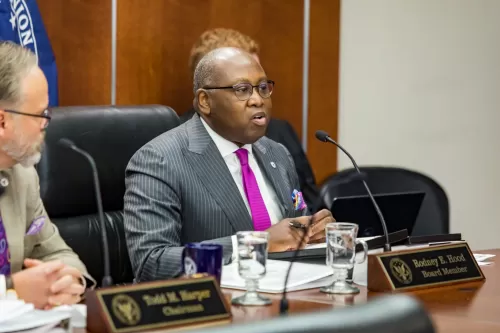NCUA Board Member Rodney Hood speaks during the October 2022 NCUA Board Meeting at the NCUA’s headquarters in Alexandria, Virginia.
As Prepared for Delivery on October 20, 2022
Thank you, Mr. Chairman, for agreeing to hold today’s briefing at my request. Given that we as, NCUA Board Members, also serve on the Central Liquidity Facility Board, I believe it is important for today’s briefing, especially as we are beginning to see liquidity pressure at some credit unions.
- Anthony, can you discuss the current state of liquidity today in the credit union system?
- How have credit unions changed their balance sheets in response to rising rates from the situation one year ago?
- How have credit union borrowings changed since December of 2021?
Thank you. The Central Liquidity Facility is a source of liquidity that is needed. It is not a question of if there will be another financial crisis but when there will be another financial crisis. Anthony, what is the best way for credit unions to use the CLF before it is too late?
In the CARES Act several years ago, Congress temporarily enhanced the CLF’s authorities. Those authorities were extended by Congress in the Consolidated Appropriations Act, 2021 for another year. These changes were critical because it temporarily relaxed the requirements on agent membership, making membership more economically feasible for corporate credit unions, which ensured that more national person credit unions had access to the CLF. This change was especially critical after the involuntary liquidation of U.S. Central in 2010.
Prior to U.S. Central’s involuntary liquidation, most natural person credit unions effectively had access to the CLF without the expense of a CLF subscription through U.S. Central. Since U.S. Central no longer exists, extending the agent membership change in the statute is critical. At Chairman Harper’s request, I have reached out to leaders on Capitol Hill to encourage them to extend this provision.
As I have said before, we should prepare for the worst and hope for the best. One of the best ways for the NCUA to prepare for the worst and hope for the best is to have a robust Central Liquidity Facility.
One of the reasons I agreed with my Board colleagues to have the CLF as a separate office is that we need to revamp the system. We need to sit down with the corporates and credit unions to create a cooperative facility that reflects the realities of today under existing powers. Anthony, what are you doing to create awareness of the CLF among credit unions, especially as the state of liquidity in the system is changing today?
Credit unions, corporates, and the CLF should sit down and discuss where the CLF should go rather than relying on this 1970s system, which was designed when the credit unions were shut out from other options, like the discount window.
I now have several questions:
- Of the CLF members, how many are less than $50 million, between $50 and$250 million, and over $250 million in assets?
- Of the credit unions below $250 million in assets that have agent membership via corporates, how many credit unions in this category are not members of a corporate and, therefore, unable to borrow through this option?
- Of those over $250 million in assets, how many also have accounts at the Federal Reserve Bank? And how many have Federal Home Loan Bank lines? For how much?
- At one time, did the CLF pay its entire net income as a dividend to credit union shareholders? When did this change?
- Who is responsible for investments in the CLF, and is there a written investment policy?
- Do we anticipate a need for CLF loans due to liquidity problems?
Thank you, Anthony. Mr. Chairman, I yield back.




